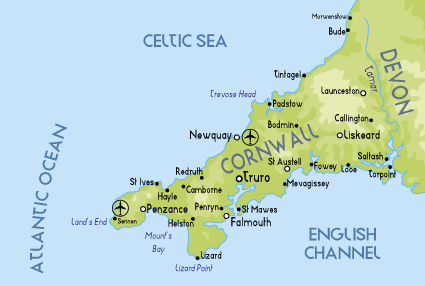Geography and History
Kernow [kəːnəʊ] is the Cornish language name for the mostly rural English county of Cornwall, which forms the westernmost and southernmost part of the island of Great Britain.
 Cornwall is almost entirely surrounded by water. On its northern coast it is bordered by the Celtic Sea, to the west by the Atlantic Ocean, to the south by the English Channel and inland to the east by the Tamar river that virtually separates it from the neighbouring county of Devon.
Cornwall is almost entirely surrounded by water. On its northern coast it is bordered by the Celtic Sea, to the west by the Atlantic Ocean, to the south by the English Channel and inland to the east by the Tamar river that virtually separates it from the neighbouring county of Devon.
Therefore, it is no surprise that Cornwall has a strong maritime history. Mostly heroic, but sometimes sinister.
Archeological evidence indicates that the area we now know as Cornwall was first inhabited in the Palaeolithic and Mesolithic periods. It continued to be settled by Neolithic and then Bronze Age people’s, and later (in the Iron Age) by Brythons, a Celtic race with distinctive cultural connections to the peoples of what is now Wales and the province of Brittany in north west France. There is very little evidence that Roman rule had much effect west of the ancient Celtic settlement located where the modern city of Exeter in neighbouring Devon now is, and as a consequence very few Roman remains have been discovered in Cornwall.
For several millennia, Cornwall, because of its relative isolation from the main centres of influence, sustained its own unique culture including its own language. However, during the 18th and 19th centuries English, being the increasingly dominant language of Great Britain, virtually replaced the native Cornish language among the wider population of the county and by the early 20th Century spoken Cornish had almost died out altogether. In the late 20th Century a movement to revive the Cornish language started to gather pace and Cornish is now a recognised minority language of the United Kingdom and is protected under the European Charter for Regional or Minority Languages. In April 2014, Cornwall was awarded National Minority Status under the umbrella of a Council of Europe convention. In practice this affords some additional protection to the wider cultural heritage of Cornwall.
Cornwall has a long history of mining for valuable minerals such as tin, copper and china clay as well as useful building materials such as slate and granite. Tin and china clay are probably the most well known and in their heyday made Cornwall’s mine owners some of the richest people in Britain with both minerals being exported around the world in large quantities.
Many examples of the distinctive stone built mine engine houses are still dotted around the old tin mining districts of the county, some of which are now designated UNESCO World Heritage Sites. Although commercial mining of tin and other metals ended in recent memory interest in restarting such mining again does occur from time to time, but no firm plans are currently in place.
Electrical and electronic communications first in Cornwall date back more than a century. In 1870, a submarine electric telegraph cable was hauled ashore and connected to a distribution facility at Porthcurno, Cornwall thus completing a massive global communications network linking Britain to the main administrative centres of its then empire and dominions. This was the 19th Century’s information super highway.
On December 12th, 1901 Guglielmo Marconi’s team successfully sent the very first transatlantic radio transmission from Poldhu Cove on the Lizard Peninsula, Cornwall to Signal Hill in St John’s, Newfoundland, Canada.
On July 11th, 1962 the first live television broadcast between Europe and the USA was sent via the Telstar satellite from the satellite earth station at Goonhilly Downs, Cornwall. The dish aerial used at Goonhilly Downs was named Arthur, in honour of King Arthur of Knights of the Round Table legend (the dramatically situated Tintagel Castle, Tintagel, Cornwall is reputed to have been King Arthur’s castle). Goonhilly’s iconic dish aerial design became a model for satellite television earth stations throughout the world.
In 2010, with financial assistance from the EU, investment from British Telecom and the backing of Cornwall Council, work started on a huge scheme to provide Cornwall with super high-speed broadband Internet connections across the county, making this the largest build to date of this kind of infrastructure ever attempted across a mostly rural area anywhere in the world. The project, named ‘Superfast Cornwall’ is expected to be completed by 2015, placing Cornwall’s businesses and homes at the forefront of super high-speed broadband communications.
